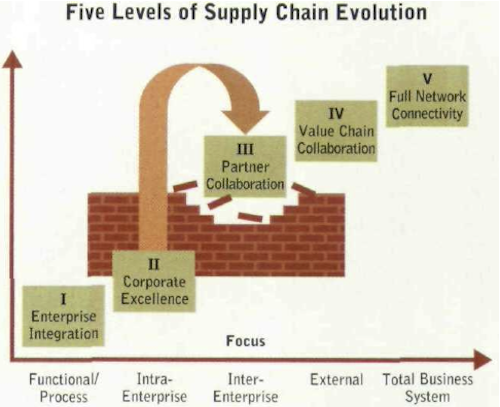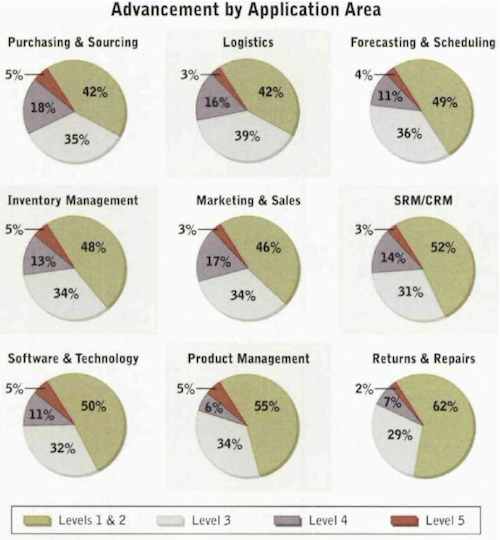Current Evolution of Supply Chain Management
One very important part of supply chain management research is the historical analysis of supply chain practices and properties over time. Just recently I published an article on the development of supply chain strategies over the course of 20 years.
Today I want to highlight a more short term, nonetheless interesting analysis done using two surveys from 2003 and 2004 on the current state and evolution of supply chain management practices.
Surveys and Foundation
The results of the first survey were published in 2003. The 2004 study was meant as a follow up. Overall 209 participants mainly from North America and Europe from more than 20 different industries took part in the survey.
A major part of the survey consists of rating the performance in different areas of supply chain management (eg. purchasing, transportation, planning, inventory management…) based on a supply chain maturity model (figure 1). The differences between the results were then analyzed.

Results
There is some identifiable progress between the two years in terms of the maturity level. Figure 2 shows the results of the self assessment for 2004. The authors state that especially the high tech sector and retail show a high percentage of level 4 and 5 companies. Comparing 2003 with 2004 the results suggest a forward movement in all key areas except for the supply chain software and technology bit.

Another part of the surveys was the strategy development within the companies. The authors conclude that
overall strategy development continues to be a weak spot among the responding companies.
Especially due to a missing link between supply chain and business strategy. In 2004, over half of the companies reported to have no supply chain strategy. Only 25% agreed that their SC strategy is integrated into the business strategy. But still, the strategies are only shared with their entire supply chain by about 15%.
The authors infer that short term cost-reduction efforts still seam to be the major focus of supply chain management. This is also confirmed by a greater focus of the companies towards supply chain initiatives on reducing cost than increasing revenues.
The authors see the following hypothesis confirmed:
- Companies and industries will vary widely in terms of their evolution agains the supply chain framework
- Impacts of supply chain initiatives will be significant and well-documented, particularly with regard to cost savings and revenue improvements.
- Companies will adopt technology solutions before improving their related processes, thereby foreclosing on the technology’s full benefits
- Inter-enterprise collaboration will be a mark of the advanced firms
- Customers will be the driving force behind many supply chain initiatives
Conclusion
Long term historical supply chain research can be a key in understanding the political drivers behind supply chain development within a company. And of course improving as a result. The research presented here is a good start in this direction but should be supported by a longer term continuity.
To be honest I was surprised that this short term view even spotted significant differences, since reaching another level in this maturity model usually would take more than one year (this then again shines back on the validity of the sample). And sadly I was not able to find a follow up article from one of the last years which repeated the study.
As always with questionnaire based surveys, especially those which have to be filled without guidance by one of the researchers, the results may heavily be biased by the interviewee and his environment.
From the deduction particularly the third hypothesis (“companies will adopt technology before changing processes”) seems to be hard to confirm in a survey alone and the presented evidence looks weaker than the others.
Poirier, C.C., & Quinn, F.J. (2004). How are we doing – A Survey of Supply Chain Progress Supply Chain Management Review, 8 (8), 24-31








Add new comment